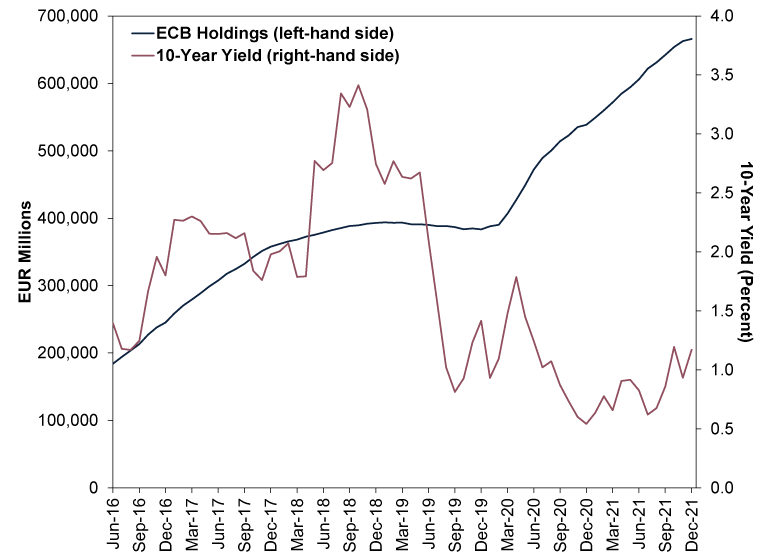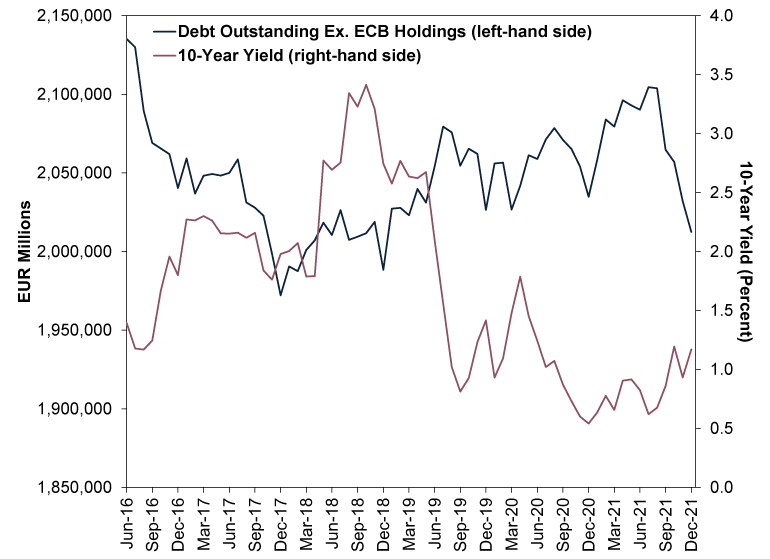Personal Wealth Management / Market Analysis
We Don't Think Italy Needs the ECB's QE
Monetary policy institutions’ bond purchases aren’t the only thing standing between Italy and a debt crisis, in our view.
A new theory about the European Central Bank (ECB) emerged amongst financial commentators we follow this week, and we think it is a juicy one: Evidently, the ECB can’t raise its benchmark interest rate aggressively because it has committed to not raising rates until it stops quantitative easing (QE) bond purchases.[i] Which it can’t do, because it would risk restarting Italy’s debt crisis.[ii] Whilst we won’t opine on the need or desirability of aggressive ECB actions, we have a couple of charts that disagree with the notion ending QE would trigger an Italian debt calamity.
Financial commentators we follow have long argued the ECB alone is propping up Italian debt and keeping the country’s borrowing costs low.[iii] Never mind that Italy’s 10-year yield was well below levels hit during the eurozone’s 2011 – 2013 debt crisis by the time the ECB announced its QE programme in January 2015.[iv] Never mind that in 2014, the average yield of all Italian bonds issued that year was just 1.35%—then the lowest on record.[v] And never mind that when the ECB stopped buying bonds in 2018, Italian yields fell on a cumulative basis. (Exhibit 1)
Oh, and never mind that even when the ECB stops buying Italian bonds whenever QE ends, it will still own over €650 billion (and counting) worth of them, and the Italian Treasury will still get back any interest paid on those holdings.[vi] As those bonds mature, barring a change in policy (which the bank hasn’t yet signalled), the ECB will use the proceeds to buy replacements. The pile of debt Italy will actually have to pay interest on is smaller today than it was when the ECB started QE, as its total Italian bond holdings dwarf the amount of debt Italy issued since QE began.[vii] We think those who dwell on the act of purchasing overlook that the stock of assets on the ECB’s balance sheet is probably more meaningful at this point.
Exhibit 1: ECB Bond Purchases and Italian Bond Yields

Source: FactSet and European Central Bank, as of 16/2/2022. Italian securities held for monetary policy purposes and Italian benchmark 10-year government bond yield, month-end levels, June 2016 – December 2021. Please note that the ECB’s data on the amount of securities held for monetary policy purposes begin at June 2016.
In our view, bond prices (which move opposite yields) move on supply and demand—like all market-set prices. As Exhibit 2 shows, even when Italy’s Treasury did manage to increase bond supply for a few years despite the ECB’s purchases, yields mostly went down. That, in our view, suggests demand is quite high, which doesn’t surprise us—there is a dearth of relatively high-yielding, quality, developed world sovereign debt these days.[viii] Pension funds are desperate to get their hands on well-paying bonds.[ix] So are other institutional and individual investors, based on our research—and they are probably particularly so in Italy, where we have observed the investment culture is much more bond-orientated than in the US. We think it is fair to argue the market is trying to tell the ECB and Italian Treasury that bond supply is just too low.
Exhibit 2: The Incredibly Shrinking Italian Bond Supply

Source: FactSet and European Central Bank, as of 16/2/2022. Italian government debt outstanding minus Italian securities held for monetary policy purposes and Italian benchmark 10-year government bond yield, month-end levels, June 2016 – December 2021. Please note that the ECB’s data on the amount of securities held for monetary policy purposes begin at June 2016.
Here is a theory we haven’t seen elsewhere: When the ECB stops buying Italian bonds, we think there is a high likelihood it will clear some space in the marketplace for other investors who are eager to buy. Supply will still be limited, due to the mountain of bonds gathering dust on the ECB’s balance sheet, but at least the monetary policy institution won’t be gobbling up billions of euros’ worth of additional bonds per month.[x] If yields rise, the corresponding lower bond prices will technically present a discount, which might lure more buyers in. That pool of buyers may be quite large, as Italian 10-year yields are now almost even with US Treasury yields for the first time in over a year.[xi] All else equal, our research finds money usually flows to the highest-yielding asset. Yes, there are some caveats for creditworthiness, but the Italian government hasn’t been spendthrift for many years, and as we showed two months ago, its debt service costs appear quite manageable. Sentiment is far out of touch with reality, in our view.
As a general rule, debt crises happen when governments can’t find buyers to purchase new bonds or refinance maturing ones. That happened to Greece a decade ago.[xii] It happened to Ireland and Portugal then as well.[xiii] But it never happened to Italy (nor Spain) during the eurozone’s debt crisis.[xiv] Commentators at many publications we follow live-blogged every debt auction with a spirit of schadenfreude, seemingly almost willing them to fail for the sake of a juicy headline—but not one auction flopped.[xv] There were buyers throughout, and we think high yields brought risk-taking investors out of the woodwork. If Italy didn’t fail to refinance debt then, when the entire world seemed to fear the eurozone was going to collapse, we doubt it will have problems whenever the ECB stops increasing its stockpile. The market appears to be telling us this—we think it is time to listen.
[i] “Raising Rates in Europe Isn’t As Simple As It Sounds,” Jon Sindreu, The Wall Street Journal, 16/2/2022. Accessed via the Internet Archive.
[ii] Ibid.
[iii] “ECB Has Central Banking’s Hardest Juggling Act,” Swaha Pattanaik, Reuters, 15/2/2022.
[iv] Source: FactSet, as of 17/2/2022.
[v] Source: Italian Treasury Department, 16/2/2022.
[vi] Source: European Central Bank, as of 16/2/2022. Additionally, please note that as a rule, monetary policy institutions return all profits from interest paid on their sovereign bond holdings to the issuer.
[vii] Source, FactSet and European Central Bank as of 17/2/2022. Italian government debt outstanding minus Italian securities held for monetary policy purposes, March 2015 – December 2021.
[viii] Source: FactSet, as of 17/2/2022. Statement based on benchmark government bond interest rates for the US, UK, Japan, Germany, France, Austria, the Netherlands, Italy and Spain.
[ix] “Bonds Beat Stocks at Pension Funds, Turning 60/40 Inside Out,” Liz McCormick and Lu Wang, Bloomberg, 28/4/2021. Accessed via ThinkAdvisor.
[x] Source: European Central Bank, as of 17/2/2022. Statement based on the ECB’s published information about its Asset Purchase Programme.
[xi] Source: FactSet, as of 17/2/2022. Statement based on 10-year benchmark Italian and US government bond yields.
[xii] “The IMF and the Crises in Greece, Ireland, and Portugal,” The Independent Evaluation Office of the International Monetary Fund, 2016.
[xiii] Ibid.
[xiv] Source: Italian Treasury Department and Spanish Treasury Department, 17/2/2022.
[xv] “Successful Italian Bond Sale Cuts Its Borrowing Costs – as it Happened,” Staff, The Guardian, 29/12/2011, and the Italian Treasury Department, as of 17/2/2022.
Get a weekly roundup of our market insights.
Sign up for our weekly e-mail newsletter.

You Imagine Your Future. We Help You Get There.
Are you ready to start your journey to a better financial future?

Markets Are Always Changing—What Can You Do About It?
Get tips for enhancing your strategy, advice for buying and selling and see where we think the market is headed next.




